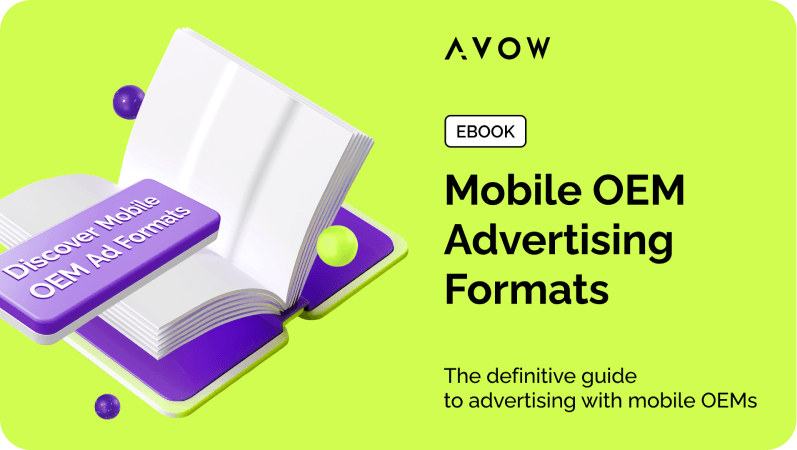Introduction to Mobile OEM Ads, OEM Ad Types, and OEM Ad Formats
Mobile OEM advertising is a distinct form of digital marketing where ads are served directly on mobile devices by the original equipment manufacturers (OEMs) themselves. This strategy not only offers advertisers a direct route to consumers but also allows them to leverage the unique capabilities and environments of various mobile OEM platforms. Understanding the types of ads that can be utilized in this space is crucial for marketers looking to optimize their mobile strategies.
Display Ads
Regular display ads are a fundamental aspect of mobile OEM advertising. These ads are integrated into the user interface of mobile devices and are designed to harmonize with the user’s interaction with their device. They can appear at various moments of device use—from navigating through device menus to interacting with native applications. The effectiveness of regular display ads lies in their ability to blend into the daily usage patterns of consumers, providing opportunities for advertisers to reach users within the organic flow of their mobile experience. The strategic placement of these ads aims to capture attention without causing significant disruption, making them a versatile tool for increasing visibility and engagement.
App Store Ads
App store ads capitalize on the environment where users are already looking to discover new apps. These advertisements are placed within the OEM’s app store, presenting a prime opportunity to influence users at a critical point of decision-making—during app exploration and download. This format allows advertisers to position their apps in front of potential users who are predisposed to installing new applications. By using targeted strategies within the app store, advertisers can significantly enhance the visibility of their apps, encouraging higher download rates and engagement directly at the source of user acquisition. The integration of app store ads with recommendation and search algorithms, together with other promotional ad formats makes mobile OEM advertising on alternative app stores much more robust than traditional app store advertising.

Display Ad Formats
In mobile OEM advertising, each ad format is designed to meet specific marketing goals and to engage users differently. Here’s an in-depth look at the ad formats used in this channel.
Native Ads
Native ads are designed to blend seamlessly with the user interface of the device or application, providing a less intrusive and more organic advertising experience. The following are some examples of various native ad placements, each tailored to integrate smoothly into specific mobile environments or applications.
Video Ads
Video ad formats with mobile OEMs can take several forms, but they all have one thing in common. They serve video ads to users in a timely and engaging manner, usually at natural transition points during the user journey or as incentivized ads to coax users to engage with the ad.
App Store Ads
OEM-owned app stores, also known as alternative app stores, offer unique advertising opportunities that help apps stand out in a crowded market. The ad formats available in these stores are designed to catch the eye of potential users at critical moments when they are actively seeking new apps. Here are detailed descriptions of some key app store ad formats:
Targeting Options
In mobile OEM advertising, targeting is crucial to ensure that ads reach the right audience at the right time, maximizing engagement and return on investment. Below you will find the list of targeting options available with mobile OEMs.

These targeting options provide advertisers with a toolkit to fine-tune their advertising campaigns to reach the most receptive audiences, enhancing both user experience and campaign effectiveness.

The Mobile OEM Advantage
What sets mobile OEM advertising apart from traditional mobile advertising? While mobile OEM advertising shares some similar ad formats with traditional mobile advertising, it sets itself apart with not only some unique ad formats but also the sheer volume and touchpoints in which it can engage with the user.
Let’s take, for example, a mobile game with action and fantasy elements…..
- Traditional mobile advertising might display the game on the Google Play Store or Apple App Store.
- The game could be advertised through banner ads in the app stores or splash ads as in-game advertisements.
- It might also appear as an ad while the user is browsing the internet, with intermittent ads.
- Beyond the app store and internet browsing, traditional mobile advertising does not consistently or effectively engage the user.
With Mobile OEM advertising, however…
- The same game could appear on the app store in multiple formats such as banner ads, pop-up ads, or as a featured app.
- Additionally, the game can appear as an icon ad in an app vault, a search result ad during a system-wide search, a lock screen ad, or an ad in a native system app, among other things.
- The app could also be advertised by a well-timed notification ad.
- Targeting can be finely tuned, for example, by using demographics to target male players who favor action games or targeting users aged 18-30 who are predisposed to fantasy games.
- Mobile OEM advertising ensures that the app reaches the most relevant audience through a variety of ad formats.
- These ad formats are tightly interwoven into the user experience of the device, engaging the user across multiple touchpoints.

What is Branding, and Why is it Important?
Branding in advertising is focused on creating and enhancing brand awareness and recognition. Unlike performance campaigns, which drive immediate conversions, branding aims to imprint a brand’s identity and values in consumers’ minds, fostering long-term growth and customer loyalty.
Branding with mobile OEMs reaches untapped audiences, often less exposed to traditional digital channels like Google or Facebook ads. This provides a less cluttered environment, making it effective for new product launches and major promotions where first impressions are crucial.
How Does Branding with Mobile OEMs Work?
Mobile OEM advertising places ads within the mobile OEM ecosystem and its alternative app stores, which operate outside traditional search and social environments. This strategy is beneficial for reaching audiences in untapped markets and offers a fresh and less competitive advertising landscape.
Key Advantages:
- Sophisticated targeting capabilities extend beyond geographic and demographic metrics to include targeting like app category and user behavior.
- Cost-effective branding with lower CPM and CPC rates allows for greater reach without higher costs.
- Brand-safe and fraud-free environments ensure genuine user engagement.
- Branding campaigns are versatile, suitable for any brand, app or no app, focusing on broader goals like increasing web traffic or promoting product launches.
Measuring Branding Campaign Success
Branding campaign success is measured by metrics that reflect brand awareness and exposure rather than direct conversions. Key metrics include:
- Reach: Total number of unique users who have seen the ad.
- Impressions: How often the ad is displayed.
- Click-Through Rate (CTR): Though secondary, it helps gauge the creativeness of the ad.
- Time Spent: Duration users engage with the ad, indicating depth of engagement.
- Sessions: Number of distinct sessions that featured the branding efforts.
These metrics aim to capture the breadth and depth of brand exposure, focusing on high reach and meaningful interactions that solidify the brand’s image in consumers’ minds.

Are You Ready to Take Your Mobile Advertising to the Next Level?
We hope this guide has provided you with valuable insights into the world of mobile OEM advertising and the transformative potential of its various ad formats. By understanding and leveraging these strategies, you can significantly enhance your app’s visibility, user engagement, and overall success in a competitive digital marketplace. Combining these with the insights and strategies from our previous guides, you will be a mobile OEM expert in no time.
Ready to take your mobile marketing to the next level? Contact us today and start harnessing the power of mobile OEM advertising and its ad formats to drive growth and engagement like never before. With the European Digital Markets Act (DMA) in full force and similar legislation in the pipeline in several other major countries—such as India, South Korea, Indonesia, the USA, the UK, and Japan—the time is ripe for advertisers to get in on the ground floor of mobile OEM advertising and alternative app stores.
But don’t just take our word for it. Come check out our series “Behind the Apps: Mobile Marketing Talks”, where Ben Barta from Tripledot Studios shares his experience and journey with AVOW and mobile OEMs, generating traffic and bringing in users from over 50 countries in the process.
Don’t miss out on this excellent opportunity to transform your app’s journey in the mobile ecosystem with AVOW.

About AVOW
AVOW is an award-winning, global app growth company specializing in mobile OEM advertising. Founded with the vision to revolutionize mobile OEM advertising, AVOW has rapidly emerged as an industry leader with more than 100 advertisers on their roster. Through its partnerships with mobile OEMs, its proprietary tech AVOW Intelligence, and the joint formation of KYLN, a premium multi-channel distribution platform for game app developers, the company provides access to over 1.56 billion daily active users and offers clients over 10 million monthly downloads.
AVOW’s strategic partnerships with the world’s leading mobile OEMs, such as Xiaomi, Oppo, Vivo, Huawei, and Transsion, are a testament to our industry standing. We provide mobile advertising and user acquisition services, along with unique access to OEM alternative app stores. Our most significant achievement is the joint formation of KYLN, a groundbreaking initiative that makes AVOW the only company globally to offer alternative app store distribution as part of its comprehensive suite of services.
AVOW has been at the forefront of mobile OEM advertising for the last six years, and all of that knowledge and experience has culminated in the release of several guides focusing on mobile OEMs. For a primer on mobile OEMs and alternative app stores or to take a deep dive into the wonderful user acquisition world of Dynamic Preloads, come check out our previous guides below.
- Everything You Need to Know About Mobile OEM Advertising and Alternative App Stores
- Dynamic Preloads and Mobile Gaming Guide
About the Author






